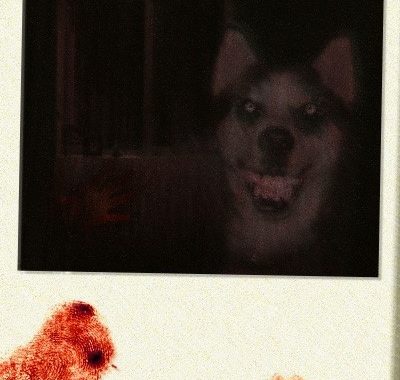According to internet legend, a cursed JPEG-file called ‘smile.jpg’ circulates online. If you find it – if someone sends it to you as an email-attachment or as a link, perhaps telling you “I’ve seen it, it’s not so bad, just spreading the word” – you will see a dog-like creature with a much too human grin. A pale hand reaches out from the darkness behind it as if to grab you and drag you into the image itself. At night, your dreams will be haunted by this creature, by Smile.dog. It tells you to ‘spread the word’, that is, to pass on the image-file to someone else. Then, and only then, will Smile.dog leave you alone. So it promises.
The story about Smile.dog is an internet urban legend, often referred to as a ‘creepypasta’. The genre’s name derives from ‘copypasta’, which is a reference to ‘copy’ and ‘paste’. Whereas copypasta can be any kind of copied and circulated material – from internet comments to messages on dating apps and questions on message-boards – creepypasta aims to disturb. To that end, it typically moves within the realms of the Gothic genre, telling stories of creatures such as monsters, ghosts and ghouls as well as Gothic tropes such as possessions, hauntings and curses. Often creepypastas connect the Gothic and the digital in ways suggestive of digital medias somewhat supernatural or otherwise otherworldly status. But why are digital technologies, the most recent in a long line of technologies intended for communication and information, apparently just as haunted as any graveyard and as filled with monsters as the spaces beneath our beds?
According to researchers within the emerging, interdisciplinary field of monster studies, monsters often embody the fears of a given sociocultural context, not least cultural anxieties concerning supposedly illicit boundary-crossings. These are exemplified by the hybridity of the monster’s body, which tends to mix and match categories such as e.g. human and animal, fact and fiction, and machine and biology. The popularity of creepypasta-monsters such as Smile.dog may indicate such boundary crises in relation to the increased use of, and reliance upon, digital technologies. With their threats of techno-supernatural contagion, surveillance, and digital stalking, these monsters tap into more general anxieties concerning the lively technologies that most of us rely on in digitalized societies; technologies that track our every move while remaining mostly obscure themselves. Such technologies are both incredibly familiar––think of how we oftentimes lay them close to where we sleep––while simultaneously disturbingly alien in the sense that the average user ultimately knows very little about how they work, what systems they rely on and communicate with, or how much data they store, and what they do with it. By using digital technologies, it is difficult to avoid taking part in a creepypasta oneself, as one’s personal information is potentially copied, pasted and circulated endlessly, sparking yet another story of monsters stalking the uncertain boundaries between self and other, fact and fiction, technology and body. Spread the word.
Author: Line Henriksen
